55:148 Digital Image Processing
55:247 Image Analysis and Understanding
Chapter 14, Motion Analysis:
·
Interest
in motion processing has increased with advances in motion analysis methodology
and processing capabilities.
·
Input
- a temporal image sequence
·
Motion
analysis often connected with real-time analysis, for example, for robot navigation.
·
Common
motion analysis problems
o
obtain
comprehensive information about moving and static objects in a scene.
o
Detecting
3D shape and relative depth from motion
·
Assumptions
- prior knowledge helps to decrease the complexity of analysis.
o
information
about the camera - mobile or static
o
information
about time interval between consecutive images
o
does
the sequence represent continuous motion.
·
No
foolproof technique in motion analysis, no general algorithm
·
Three
main groups of motion-related problems
·
Motion
detection
o
simplest,
registers any detected motion
o
security
o
single
static camera
·
Moving
object detection and location
o
Camera
usually in a static location and objects are moving
o
or
camera moves and objects are static
o
considerably
more difficult in comparison with the first group.
o
Moving
object detection only - solution based on motion-based segmentation methods
o
More
complex problems include detection of a moving object, trajectory of its motion,
prediction of its future trajectory
o
Image
object-matching techniques often used
o
direct
matching
o
matching
of object features,
o
matching
of specific representative object points (corners, etc.)
o
representing
moving objects as graphs and matching of these graphs
o
Practical
examples
§
cloud
tracking from a sequence of satellite meteorological data
§
cloud
character and motion prediction,
§
motion
analysis for autonomous road vehicles,
§
automatic
satellite location by detecting specific points of interest on the
§
Earth's
surface
§
city
traffic analysis
§
many
military applications.
§
Most
complex methods work even if both camera and objects are moving.
·
Derivation
of 3D object properties from 2D projections acquired at different time instants
of object motion - 3D object reconstruction problem
·
Motion
analysis = dynamic image analysis - frequently based on a small number of
consecutive images
·
Similar
to analysis of static images, motion analyzed at a higher level, looking for
correspondence between pairs of points of interest in sequential images.
·
Extensive
application of matching
·
2D
representation of 3D motion - motion field
o
each
point assigned a velocity vector corresponding to
§
motion
direction
§
velocity
§
distance
from an observer
·
Motion
from optical flow
o
requires
a very small time distance between consecutive images
o
no
significant changes between two consecutive images
§
motion
direction
§
motion
velocity
o
Aim
of optical flow-based image analysis - determine a motion field.
o
Illumination
changes reflected in optical flow
o
Object
motion parameters derived from optical flow vectors
o
Estimates
of optical flow or point correspondence are noisy
o
3D
interpretation of motion is ill-conditioned
o
Requires
high precision of optical flow or point correspondence.
·
Object
assumptions can help localize moving objects …
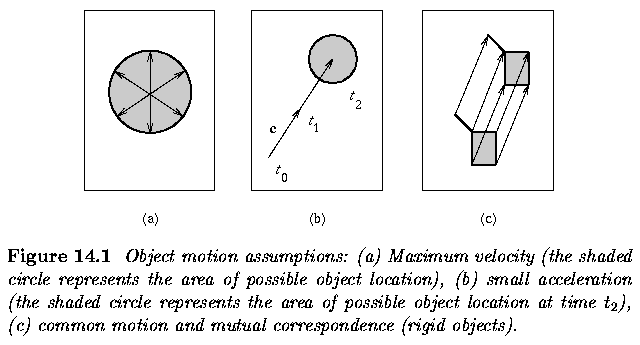
·
Maximum
velocity
·
Small
acceleration
·
Common
motion
·
Mutual
correspondence
Differential
motion analysis methods
·
Difference
image d(i,j)
- binary image
·
non-zero values - areas
with motion = difference between gray-levels in consecutive images f_1 and
f_2:

·
epsilon
is a small positive number
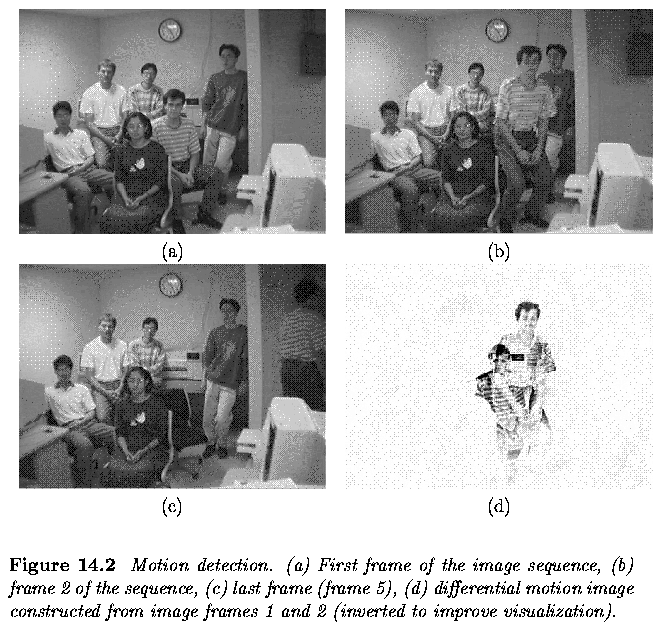
·
f_1,
f_2 - two consecutive images separated by a time interval.
·
d(i,j)
- difference image has value one if:
o
f_1(i,j)
is a pixel on a moving object
o
f_2(i,j)
is a pixel on the static background
o
or
vice versa
o
f_1(i,j)
is a pixel on a moving object
o
f_2(i,j)
is a pixel on another moving object
o
f_1(i,j)
is a pixel on a moving object
o
f_2(i,j)
is a pixel on a different part of the same moving object
o
Noise,
inaccuracies of stationary camera positioning, etc.
·
Results
highly dependent on object--background contrast
·
Trajectories
detected using differential image motion analysis may not reveal the direction
of the motion.
·
If
direction is needed, cumulative difference image may help
o
constructed
from a sequence of n images, with first image f_1 being a reference image
o
how
often
·
by
how much the image gray-level is different from the gray-level of the reference
image
·
weight
coefficients a_k - significance of images in the sequence:

·
more
recent images may be given greater weights to reflect the importance of current
motion
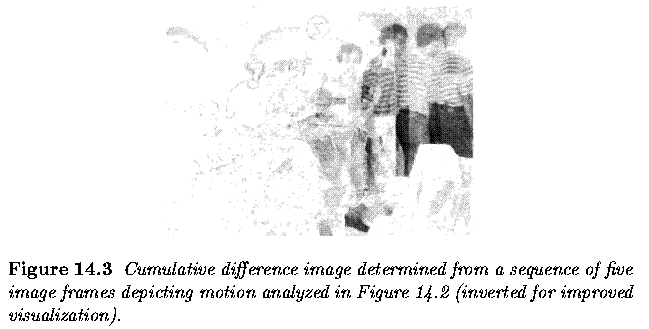
·
A
problem may be the impossibility of a static reference scene if the motion
never ends
·
a
learning stage must construct the reference image
·
Motion
trajectories
o
often
only the center of gravity trajectory needed
·
Task
is simplified if objects can be segmented in the first image of sequence.
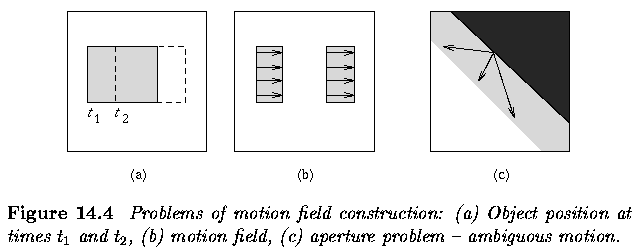
·
Difference
image carries information about presence of motion, characteristics of motion
derived from it are not very reliable. The motion
·
Robustness
can be improved if intensity characteristics are compared.
·
Robust
motion detection - comparea corresponding areas of the image
·
Detecting
moving edges
·
detection
of slow-moving edges and weak edges
·
Moving
edges can be determined by logical AND operations of the spatial and temporal
image edges

·
S(i,j)
- edge magnitudes in one of the two frames
·
D(i,j)
- absolute difference image
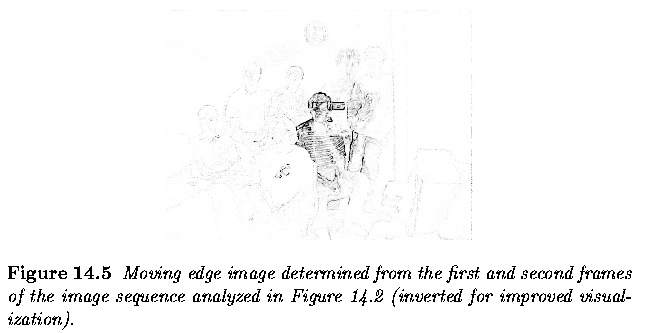
Last Modified: 2003
![[Go Back]](file:///D%7C/Classes/ImageUnderstandingClass/..%5CIMAGES%5Cnext.gif)






![]()
